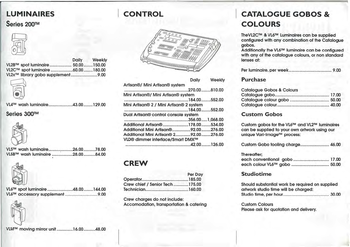Until the late 20th century, the colour, focus and other adjustable features of stage lights were almost always set manually, with only the brightness remote-controlled. In the 1980s a revolution began: the automation of all the variable parameters.
With the growth of the music industry from the 1960s, bands and promotors sought to deliver larger and more impressive shows to attract the audience, with lighting a key part of the spectacle. In the late 1970s, the Dallas, Texas-based light and sound company Showco wanted a light that could change colour, and were working on a system that did this by turning dichroic filters (Q3326) to different angles in the beam. It is reported that Jack Maxson, a founding partner of Showco, said: ‘Add two more motors and it moves’. Motors to move the light from side to side and up and down (pan and tilt) were added, and the result was demonstrated to the rock band Genesis in 1980, which invested $1m in what was to become the first Vari-Lite (Q30539).
Although some moving lights had existed before 1980, the Vari-Lite was the template on which most moving lights have since been based. Showco became Vari-Lite the company and started production, with successive models adding further features: more flexible colour systems, motorised gobos, variable beam size, and control of the edge hardness of the beam. Wash lights were added to the original profiles, for a wider, soft-edged beam of light. Vari-Lite also created a lighting console to control and programme the new lighting equipment, using a proprietary digital control protocol to communicate between the console and the lights. It was not possible to buy Vari-Lite equipment, only rent it directly from the company as a system, complete with a Vari-Lite operator.
In the late 1980s, other manufacturers began to develop their own automated lights. Unlike Vari-Lite, these companies used the then new DMX 512 control protocol (Q3957), so the automated lights didn’t have to be a separate system to the rest of the rig. After various legal disputes with Vari-Lite over patents, these other manufacturers became successful in the market, and Vari-Lite lost its near-monopoly position, eventually having to abandon its rental-only business model. From the 1990s, Vari-Lite introduced models that could be purchased, controlled by the now standard DMX protocol. Vari-Lite became just one moving light manufacturer amongst several, and the market has since grown further, with a wide variety of manufactures and products available for lighting designers to specify.
Parallel to this development, driven mainly by live music, the needs of the disco and club market were being fulfilled, generally by other manufacturers. Here, the requirement was for lights that could move and change very rapidly, to provide high-energy dynamic effects to accompany dance music. Moving mirror lights (‘scanners’) were ideal, and these developed from the mid 1980s. They used a light-weight motorised mirror that could move extremely rapidly to direct the beam, while all the other functions (light source, colour mixing, gobo wheels, and so on) were contained in a static housing.
For the concerts and clubs, the emphasis was on bright lights that could move rapidly, with rich colours and lots of beam effects such as gobos and prisms. For theatre and opera, the needs were different. Speed of movement was largely unimportant; the need was for subtle colours with excellent colour rendering to match the non-moving lights, very precise positioning, and above all, quiet operation without motor and cooling-fan noise. Specialist theatre lighting manufacturers introduced such products, for example the 1988 Niethammer (Q13353) Varimot motorised profile light, controlled with its own control protocol from the AVAB Viking console, and the 1987 Strand Lighting (Q64) PALS system, controlled via a PC computer with cues triggered from a Strand console. Motorised brackets to automate existing, conventional spotlights with pan and tilt were also manufactured. Later, the main moving light manufacturers created dedicated theatre models.
The work at Showco in the late 1970s to develop colour changers for rock concerts that led to the Vari-Lite led to another significant piece of lighting technology: the colour scroller (Q3184). Pieces of gel, taped together without a frame, were wound from one spindle to another by motors, passing in front of the light as they did so. LED colour-mixing lights have replaced the scroller, but for several decades they were key to adding flexibility to rigs.
Since the 1980s, stage lighting has been revolutionised by the automation of lights. Previously the emphasis was on the control of intensity over time; now all the parameters are controllable during the performance, greatly increasing the possibilities available to lighting designers. Automated lighting has changed the technology, the practices and the very way stage performances are lit.

